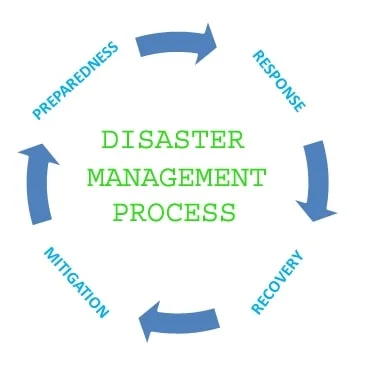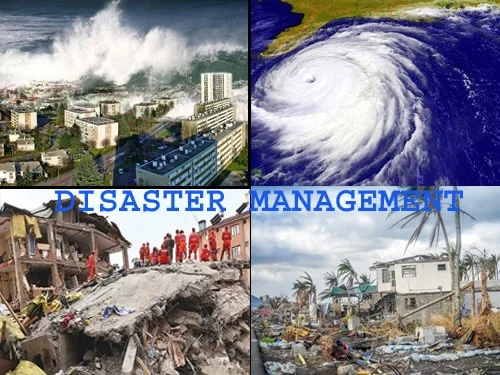Disaster Management can be defined as the organization and management of resources and responsibilities for dealing with all humanitarian aspects of emergencies, in particular, preparedness, response, and protect critical infrastructures from severe damages when natural or human-made calamities and catastrophic even occur.
Disaster Management means a continuous & integrated process of planning, coordinating, and implementing measures that are necessary or expedient for
- Prevention of danger or threat of any disaster.
- Mitigation or reduction of risk of any disaster or its severity or consequences.
- Capacity building.
- Preparedness to deal with any disaster.
- Prompt responses to any threatening disaster situation or disaster.
- Assessing the severity or magnitude of effect of any disaster, evacuation, rescue& relief.
- Rehabilitation & Reconstruction.
Disaster A Catastrophe, mishap, calamity in any area arising from natural or manmade causes, which results in substantial loss of life or human suffering, damage & destruction of property, environment and is of such nature or magnitude as to be beyond the coping capacity of the community of the affected area.
Table of Contents
Vulnerability:
Vulnerability means characteristics of a person, group of persons, (community) or their resources (i.e. property, infrastructure, environment, or ecosystem) and the concerned situation that influences their capacity to anticipate, cope with, resist and recover from the impact of nature or anthropogenic hazard. It involves a combination of factors that determine the degree to which someone’s life, livelihood, property, ecosystem, and other assets are put at risk by discrete and identifiable events in nature and in society. Society vulnerability enumerates upon the fact that in our society some groups are more prone to damage and losses in context to different hazards.
Disaster Risk:
Risk is an indicator function of the probability of occurrence of a hazardous event and the extent of its damage ability in terms of life lost, no of injury, damage to property, environment, infrastructure, and disruption of economic activity. Disaster risk is an expression of likely hood that a particular hazard or hazard event can become a disaster (by causing damage &losses)
Disaster = (Hazard risk x Vulnerability) / Capacity
Risk= Po x Ed
Where Po= Probability of occurrence.
Ed= Extent of damageability.
Types of Disaster
Natural disaster
- Meteorological
- Topographical
- Environmental
Manmade Disaster
- Technological
- Industrial accident (Like Bhopal gas tragedy).
- Security related.
Disaster preparedness
Preparedness means a state of readiness to deal with a threatening disaster situation or disaster and the immediate effect thereof. It includes periodical, administrative, individual, and community actions to minimize loss of life, rescue, relief & rehabilitation.
Disaster mitigation
Mitigation refers to the sum of human intervention taken for reducing risk (by preventing and containing the hazard, avoiding or reducing exposure, enhancing tolerance) minimizing the impact of the hazard, or threatening disaster situation.
Disaster Mitigation is of two types
- Structural
- Non Structural
Structural disaster mitigation:
A structural measure refers to engineering measures or physical construction to reduce or avoid possible impacts of a hazard.
Non-structural disaster mitigation:
A non-structural refers to policies, awareness, generation, knowledge development legal intervention which can reduce risk.
Broadly there are 4 principal approaches to dealing with disaster risk & its management.
- Engineering centric structural mitigation.
- Community centric preparedness.
- Incident command system (in emergency).
- Ecosystem approach to Disaster risk reduction (Eco DRR).

National disaster policy
The National DM Policy 2009, announced. The policy is made for building a safe and disaster-resilient India. It elaborates the importance of Disaster management in the development process creation of mitigation reserves, risk assessment and vulnerability mapping, and other mitigation measures, etc.
Classification of Disaster
The classification of disaster can be based on originating agent, or the impact, or whether the disaster is preceded by a warning phase or not.
The disaster could be classified in 2 major categories.
- Natural disaster
- Manmade disaster
With further sub-classification as
- Major disaster
- Minor disaster
| NATURAL DISASTER | HUMAN-MADE DISASTER | OTHER DISASTER |
| MAJOR | MAJOR | MAJOR |
| 1. Earthquake 2. Flood 3. Drought 4. Cyclone | 1. Communal riot 2. Ethnic conflicts 3. Refugee situation 4. Terrorism | 1. Epidemics 2. Industrial disaster 3. Fire 4. Policy induced disaster |
| MINOR | MINOR | MINOR |
| 1. Heatwave 2. Cold wave 3. Landslide 4. Avalanche 5. Tornado 6. Hailstorm | 1. Festival pilgrimage related disaster 2. Food poisoning 3. Alcohol tragedy |

